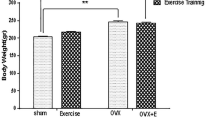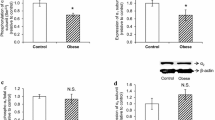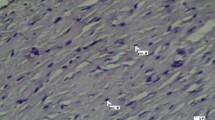Abstract
Estrogens exert their biological roles mainly through estrogen receptors (ER) that function as ligand-activated transcription factors. ER content in a cell is regulated by many factors and is decisive for estrogen action. The purpose of the present study was to investigate the influence of an 8-wk endurance training program on ER expression in the liver, right atrium (RA), and left ventricle (LV) of intact and ovariectomized (Ovx) rats. We measured ERα and ERβ mRNA content by reverse transcription-polymerase chain reaction (RT-PCR). We found an important increase in ERα mRNA levels in the liver (300%; P < 0.01) and in ERβ mRNA levels in the RA (200%; P < 0.05), and a marked decrease in ERα (80%; P < 0.01) and ERβ (40%; P < 0.05) transcripts content in the LV of intact rats after endurance training. On the other hand, ERα mRNA levels were depressed by 50% (P < 0.01) in the liver, and increased by 60% (P < 0.01) in LV of Ovx rats after exercise training. These results first indicate that endurance training is associated with modifications of ER transcripts levels in the liver, LV, and RA of female rats. More specifically, these effects are tissue and isoform-specific and the direction of the response (increase or decrease) is different in intact and Ovx rats. It is suggested that some of the adaptations to endurance training in liver and heart may be mediated by an ER-dependent mechanism.


Similar content being viewed by others
References
Ciocca DR, Vargas Roig LM (1995) Estrogen receptors in human nontarget tissues: biological and clinical implications. Endocr Rev 16:35–62
Matthews J, Gustafsson JA (2003) Estrogen signaling: a subtle balance between ERα and ERβ. Mol Interv 3:281–292
Kato S, Endoh H, Masuhiro Y et al (1995) Activation of the estrogen receptor through phosphorylation by mitogen-activated protein kinase. Science 270:1491–1494
Brindley DN, Salter AM (1991) Hormonal regulation of the hepatic low density lipoprotein receptor and the catabolism of low density lipoproteins: relationship with the secretion of very low density lipoproteins. Prog Lipid Res 30:349–360
Farsetti A, Misiti S, Citarella F et al (1995) Molecular basis of estrogen regulation of Hageman factor XII gene expression. Endocrinology 136:5076–5083
Klett C, Ganten D, Hellmann W (1992) Regulation of hepatic angiotensinogen synthesis and secretion by steroid hormones. Endocrinology 130:3660–3668
Stavreus-Evers A, Parini P, Freyschuss B (2001) Estrogenic influence on the regulation of hepatic estrogen receptor-α and serum level of angiotensinogen in female rats. J Steroid Biochem Mol Biol 78:83–88
Kuiper GGJM, Carlsson B, Grandien K (1997) Comparison of the ligand binding specificity and transcript tissue distribution of estrogen receptors α and β. Endocrinology 138:863–870
Booth EA, Obeid NR, Lucchesi BR (2005) Activation of estrogen receptor-α protects the in vivo rabbit heart from ischemia-reperfusion injury. Am J Physiol Heart Circ Physiol 289:H2039–H2047
Jovanovic S, Jovanovic A, Shen WK et al (2000) Low concentrations of 17β-estradiol protect single cardiac cells against metabolic stress-induced Ca2+ loading. J Am Coll Cardiol 36:948–952
Babiker FA, Lips D, Meyer R et al (2006) Estrogen receptor β protects the murine heart against left ventricular hypertrophy. Arterioscler Thromb Vasc Biol 26:1524–1530
Rudling M, Norstedt G, Olivecrona H et al (1992) Importance of growth hormone for the induction of hepatic low density lipoprotein receptors. Proc Natl Acad Sci 89:6983–6987
Webb P, Lopez GN, Greene GL et al (1992) The limits of the cellular capacity to mediate an estrogen response. Mol Endocrinol 6:157–167
Freyschuss B, Sahlin L, Masironi B et al (1994) The hormonal regulation of the oestrogen receptor in rat liver: an interplay involving growth hormone, thyroid hormones and glucocorticoids. J Endocrinol 142:285–298
Norstedt G, Wrange O, Gustafsson JA (1981) Multihormonal regulation of the estrogen receptor in rat liver. Endocrinology 108:1190–1196
Stavreus-Evers AC, Freyschuss B, Eriksson HA (1997) Hormonal regulation of the estrogen receptor in primary cultures of hepatocytes from female rats. Steroids 62:647–654
Dickson RB, Eisenfeld AJ (1979) Estrogen receptor in liver of male and female rats: endocrine regulation and molecular properties. Biol Reprod 21:1105–1114
Eriksson HA (1982) Different regulation of the concentration of estrogen receptors in the rat liver and uterus following ovariectomy. FEBS Lett 149:91–95
Thompson C, Lucier GW (1983) Hepatic estrogen responsiveness. Mol Pharmacol 24:69–76
Lax ER, Tamulevicius P, Muller A et al (1983) Hepatic nuclear estrogen receptor concentrations in the rat – influence of age, sex, gestation, lactation and estrous cycle. J Steroid Biochem 19:1083–1088
Marr W, White JO, Elder MG et al (1980) Nucleo-cytoplasmic relationships of oestrogen receptors in rat liver during the oestrous cycle and in response to administered natural and synthetic oestrogen. Biochem J 190:17–25
Staels B, Jansen H, Van Tol A et al (1990) Development, food intake, and ethinylestradiol influence hepatic triglyceride lipase and LDL-receptor mRNA levels in rats. J Lipid Res 31:1211–1218
Jankowski M, Rachelska G, Donghao W et al (2001) Estrogen receptors activate atrial natriuretic peptide in the rat heart. Proc Natl Acad Sci 98:11765–11770
Lemoine S, Granier P, Tiffoche C et al (2002) Effect of endurance training on oestrogen receptor alpha transcripts in rat skeletal muscle. Acta Physiol Scand 174:283–289
Lemoine S, Granier P, Tiffoche C et al (2002) Effect of endurance training on oestrogen receptor alpha expression in different rat skeletal muscle type. Acta Physiol Scand 175:211–217
Wiik A, Gustafsson T, Esbjornsson M et al (2005) Expression of oestrogen receptor α and β is higher in skeletal muscle of highly endurance-trained than of moderately active men. Acta Physiol Scand 184:105–112
Bergeron J, Couillard C, Després JP et al (2001) Race differences in the response of postheparin plasma lipoprotein lipase and hepatic lipase activities to endurance exercise training in men. Results from the HERITAGE family study. Atherosclerosis 159:399–406
Jones DR, Schmidt RJ, Pickart RT et al (2002) Estrogen receptor-mediated repression of human hepatic lipase gene transcription. J Lipid Res 43:383–391
Quindry J, French J, Hamilton K et al (2005) Exercise training provides cardioprotection against ischemia-reperfusion induced apoptosis in young and old animals. Exp Gerontol 40:416–425
Xu Y, Arenas IA, Armstrong SJ et al (2006) Estrogen improves cardiac recovery after ischemia/reperfusion by decreasing tumor necrosis factor-α. Cardiovasc Res 69:836–844
Picard F, Deshaies Y, Lalonde J et al (2000) Effects of the estrogen antagonist EM-652.HCL on energy balance and lipid metabolism in ovariectomized rats. Int J Obes 24:830–840
Torto R, Boghossian S, Dube MG et al (2006) Central leptin gene therapy blocks ovariectomy-induced adiposity. Obesity 14:1312–1319
Lemieux C, Phaneuf D, Labrie F et al (2005) Estrogen receptor α-mediated adiposity-lowering and hypocholesterolemic actions of the selective estrogen receptor modulator acolbifen. Int J Obes 29:1236–1244
Latour MG, Shinoda M, Lavoie JM (2001) Metabolic effects of physical training in ovariectomized and hyperestrogenic rats. J Appl Physiol 90:235–241
Shinoda M, Latour MG, Lavoie JM (2002) Effects of physical training on body composition and organ weights in ovariectomized and hyperestrogenic rats. Int J Obes 26:335–343
Bupha-Intr T, Wattanapermpool J (2004) Cardioprotective effects of exercise training on myofilament calcium activation in ovariectomized rats. J Appl Physiol 96:1755–1760
Moien-Afshari F, Kenyon E, Choy JC et al (2003) Long-term effects of ovariectomy and estrogen replacement treatment on endothelial function in mature rats. Maturitas 45:213–223
Patten RD, Pourati I, Aronovitz MJ et al (2004) 17β-estradiol reduces cardiomyocyte apoptosis in vivo and in vitro via activation of phospho-inositide-3 kinase/Akt signaling. Circ Res 95:692–699
Rogers J, Sheriff DD (2004) Role of estrogen in nitric oxide- and prostaglandin-dependant modulation of vascular conductance during treadmill locomotion in rats. J Appl Physiol 97:756–763
Robertson MC, Owens RE, Klindt J et al (1984) Ovariectomy leads to a rapid increase in rat placental lactogen secretion. Endocrinology 114:1805–1811
Mohamed MK, Abdel-Rahman AA (2000) Effect of long-term ovariectomy and estrogen replacement on the expression of estrogen receptor gene in female rat. Eur J Endocrinol 142:307–314
Hood DA, Irrcher I, Ljubicic V et al (2006) Coordination of metabolic plasticity in skeletal muscle. J Exp Biol 209:2265–2275
Thompson PD, Cullinane EM, Sady SP et al (1991) High density lipoprotein metabolism in endurance athletes and sedentary men. Circulation 84:140–152
Mahmoodzadeh S, Eder S, Nordmeyer J et al (2006) Estrogen receptor alpha up-regulation and redistribution in human heart failure. FASEB J 20:929–934
Nordmeyer J, Eder S, Mahmoodzadeh S et al (2004) Upregulation of myocardial estrogen receptors in human aortic stenosis. Circulation 110:3270–3275
Brown DA, Moore RL (2007) Cardioprotection acquired through exercise. J Appl Physiol (Epub ahead of print). DOI: 10.1152/japplphysiol.00464.2007
Yu HP, Shimizu T, Choudhry MA et al (2006) Mechanism of cardioprotection following trauma-hemorrhagic shock by a selective estrogen receptor-beta agonist: up-regulation of cardiac heat shock factor-1 and heat shock proteins. J Mol Cell Cardiol 40:185–194
Hsieh YC, Yu HP, Suzuki T et al (2006) Upregulation of mitochondrial respiratory complex IV by estrogen receptor-beta is critical for inhibiting mitochondrial apoptotic signaling and restoring cardiac functions following trauma-hemorrhage. J Mol Cell Cardiol 41:511–521
Gabel SA, Walker VR, London RE et al (2005) Estrogen receptor beta mediates gender differences in ischemia/reperfusion injury. J Mol Cell Cardiol 38:289–297
Jazbutyte V, Hu K, Kruchten P et al (2006) Aging reduces the efficacy of estrogen substitution to attenuate cardiac hypertrophy in female spontaneously hypertensive rats. Hypertension 48:579–586
Bunone G, Briand PA, Miksicek RJ et al (1996) Activation of the unliganded estrogen receptor by EGF involves the MAP kinase pathway and direct phosphorylation. EMBO J 15:2174–2183
Iemitsu M, Maeda S, Jesmin S et al (2006) Activation pattern of MAPK signaling in the hearts of trained and untrained rats following a single bout of exercise. J Appl Physiol 101:151–163
Widegren U, Jiang XJ, Krook A et al (1998) Divergent effects of exercise on metabolic and mitogenic signaling pathways in human skeletal muscle. FASEB J 12:1379–1389
Carlberg KA, Fregly MJ (1985) Disruption of estrous cycles in exercise-trained rats. Proc Soc Exp Biol Med 179:21–24
Shupnik MA, Gordon MS, Chin WW (1989) Tissue-specific regulation of rat estrogen receptor mRNAs. Mol Endocrinol 3:660–665
Harber VJ (2000) Menstrual dysfunction in athletes: an energetic challenge. Exerc Sport Sci Rev 28:19–23
Williams NI, Helmreich DL, Parfitt DB et al (2001) Evidence for a causal role of low energy availability in the induction of menstrual cycle disturbances during strenuous exercise training. J Clin Endocrinol Metab 86:5184–5193
Acknowledgements
This work was supported by grants from the Natural Sciences and Engineering Research Council of Canada (NSERC; JML) and the Canadian Institutes of Health Research (CIHR; JML and DP), and from CIHR MOP 53217 and CIHR NET SRD-63193, Heart and Stroke Foundation of Canada (JG and MJ).
Author information
Authors and Affiliations
Corresponding author
Rights and permissions
About this article
Cite this article
Paquette, A., Wang, D., Gauthier, MS. et al. Specific adaptations of estrogen receptor α and β transcripts in liver and heart after endurance training in rats. Mol Cell Biochem 306, 179–187 (2007). https://doi.org/10.1007/s11010-007-9568-5
Received:
Accepted:
Published:
Issue Date:
DOI: https://doi.org/10.1007/s11010-007-9568-5




